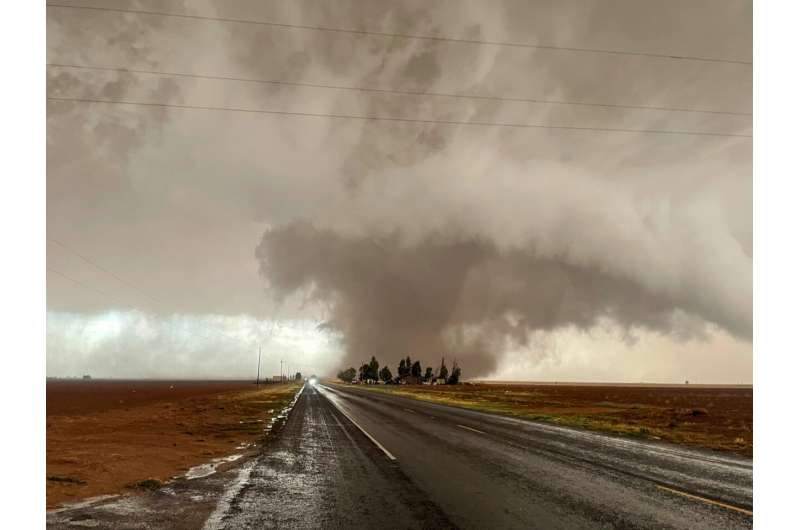New research backs improved translations of weather forecasts for US Spanish speakers

New social science research published online today in the Bulletin of the American Meteorological Society shows that the Spanish words currently used by NOAA's National Weather Service and the Federal Emergency Management Agency (FEMA) for tornado warnings do not carry the same level of urgency needed to spur protective action as the English words used for these warnings. Though the research focuses on alert language for severe weather and tornadoes, it has implications for all weather hazards.
"Our research shows significant inequities in understanding watches and warnings between English and Spanish speakers," said Joseph Trujillo-Falcón, the lead author of the publication, who works for NOAA's Cooperative Institute for Severe and High-Impact Weather Research and Operations in Norman, Oklahoma. "To reduce this language barrier, our data supports using the Spanish word 'vigilancia' for a tornado watch and the Spanish word 'alerta' for a tornado warning," said Trujillo-Falcón.
NOAA currently uses the Spanish word "vigilancia" for a watch and "aviso" for a warning. On its website, FEMA uses "advertencia" and "vigilancia" for a watch and "aviso" for a warning, but also uses "advertencia" and "amenaza" for watch and warning, respectively, in their social media messaging.
The National Weather Service issues tornado watches when severe thunderstorms and tornadoes are possible in and near the watch area. An issuance of a watch does not mean that a tornado will occur. A tornado warning is issued when a tornado is imminent or happening. When a tornado warning is issued, people should seek safe shelter immediately.
Trujillo-Falcón is working closely with the National Weather Service to share the research and expects that any changes to the Spanish words for watches and warnings and other alerts will occur after further research and involvement of U.S. Spanish-speaking communities. "We published this study to raise awareness of the issue and we want to work closely and collaboratively with NOAA's National Weather Service and emergency management partners to develop a solution," he said.
"This important social science research confirms and builds on information we've collected through surveys as part of our ongoing Hazard Simplification initiative," said Allison Allen, director of the NOAA National Weather Service Analyze, Forecast and Support Office. "Before we formalize our use of Spanish-language terminology, we will carefully consider these findings as we determine the most effective Spanish-language translations for our alerts."
Trujillo-Falcón's research, outlined in the Bulletin article, is based on results from a survey conducted annually by the University of Oklahoma Institute for Public Policy Research and Analysis. Called the Severe Weather and Society Survey, this survey has been given in English from 2017 to 2020 and for the first time was given in both English and Spanish in 2021.
The survey asked Spanish and English speakers questions in their respective languages about tornado watches and warnings. Researchers found significant differences in how English and Spanish speakers understood these terms. For example, while 66% of the English speakers correctly identified the meaning of a tornado watch as an early notice of possible severe weather, only 38% of the Spanish speakers chose this definition.
The survey respondents were also asked to rank five Spanish words according to the level of urgency they expressed. Spanish speakers agreed that the words "emergencia," "amenaza" and "alerta" expressed the most urgency, while the words "vigilancia" and "aviso"—which are currently used by the National Weather Service for watches and warnings, respectively—did not communicate as high a level of urgency as the other three words.
Trujillo-Falcón said the research validated earlier studies showing that literal translations of English words to Spanish do not always carry the same level of urgency. He added that while the word "aviso" is a literal Spanish translation of the English word warning, the word "aviso" in Spanish is more like advice you might get from a parent, but does not carry the urgency of an official warning to take action.
The new research paper, "¿Aviso o Alerta? Developing effective, inclusive and consistent watch and warning translations for U.S. Spanish speakers," can be found in the Bulletin of the American Meteorological Society.
More information: Joseph E. Trujillo-Falcón et al, ¿Aviso o Alerta? Developing Effective, Inclusive, and Consistent Watch and Warning Translations for U.S. Spanish Speakers, Bulletin of the American Meteorological Society (2022). DOI: 10.1175/BAMS-D-22-0050.1
Journal information: Bulletin of the American Meteorological Society
Provided by NOAA Headquarters



















